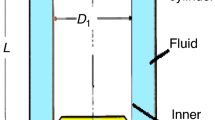Abstract
Autonomous capillary systems (CSs) are microfluidic systems inside which liquids move owing to capillary forces. CSs can in principle bring the high-performances of microfluidic-based analytical devices to near patient and environmental testing applications. In this paper, we show how wettable capillary valves can enhance CSs with novel functionalities, such as delaying and stopping liquids in microchannels. The valves employ an abruptly changing geometry of the flow path to delay a moving liquid filling front in a wettable microchannel. We show how to combine delay valves with capillary pumps, prevent shortcuts of liquid along the corners of microfluidic channels, stop liquids filling microchannels from a few seconds to over 30 min, trigger valves using two liquid fronts merging, and time a liquid using parallel microfluidic paths converging to a trigger valve. All together, these concepts should add functionality to passive microfluidic systems without departing from their initial simplicity of use.






Similar content being viewed by others
References
Andersson H, van der Wijngaart W, Griss P, Niklaus F, Stemme G (2001) Hydrophobic valves of plasma deposited octafluorocyclobutane in drie channels. Sens Actuators B 75:136–141
Beebe DJ, Moore JS, Bauer JM, Yu Q, Liu RH, Devadoss C, Jo B (2000) Functional hydrogel structures for autonomous flow control inside microfluidic channels. Nature 404(6778):588–590
Beebe DJ, Mensing GA, Walker GM (2002) Physics and applications of microfluidics in biology. Annu Rev Biomed Eng 4:261–286
Bresslauer DN, Lee PJ, Lee LP (2006) Microfluidics-based systems biology. Mol BioSyst 2:97–112
Cesaro-Tadic S, Dernick G, Juncker D, Buurman G, Kropshofer H, Michel B, Fattinger C, Delamarche E (2004) High-sensitivity miniaturized immunoassays for tumor necrosis factor alpha using microfluidic systems. Lab Chip 4(6):563–569
Chen J, Huang P, Lin M (2007) Analysis and experiment of capillary valves for microfluidics on a rotating disk. Microfluid Nanofluid (in press). doi:10.1007/s10404-007-0196-x
Cheng JY, Hsiung LC (2004) Electrowetting (ew)-based valve combined with hydrophilic teflon microfluidic guidance in controlling continuous fluid flow. Biomed Microdev 6(4):341–347
Cheow LF, Yobas L, Kwong DL (2007) Digital microfluidics: droplet based logic gates. Appl Phys Lett 90(5):054107
Cho H, Kim HY, Kang JY, Kim TS (2007) How the capillary burst microvalve works. J Colloid Interface Sci 306(2):379–385
Delamarche E, Juncker D, Schmid H (2005) Microfluidics for processing surfaces and miniaturizing biological assays. Adv Mater 17:2911–2933
DeMello AJ (2006) Control and detection of chemical reactions in microfluidic systems. Nature 442(7101):394–402
Dittrich PS, Tachikawa K, Manz A (2006) Micro total analysis systems. Latest advancements and trends. Anal Chem 78(12):3887–3907
Gliere A, Delattre C (2006) Modeling and fabrication of capillary stop valves for planar microfluidic systems. Sens Actuators A Phys 130–131:601–608
Juncker D, Schmid H, Drechsler U, Wolf H, Wolf M, Michel B, de Rooij N, Delamarche E (2002) Autonomous microfluidic capillary system. Anal Chem 74(24):6139–6144
Khandurina J, Guttman A (2002) Bioanalysis in microfluidic devices. J Chromatogr A 943(2):159–183
Krishnan A, Wilson A, Sturgeon J, Siedlecki CA, Vogler EA (2002) Liquid-vapor interfacial tension of blood plasma, serum and purified protein constituents thereof. Biomaterials 26(17):3445–3453
Leu TS, Chang PY (2004) Pressure barrier of capillary stop valves in micro sample separators. Sens Actuators A Phys 115:508–515
Lu CM, Xie YB, Yang Y, Cheng MMC, Koh CG, Bai YL, Lee LJ (2007) New valve and bonding designs for microfluidic biochips containing proteins. Anal Chem 79(3):994–1001
Man FP, Mastrangelo CH, Burns MA, Burke DT (1998) Microfabricated capillarity-driven stop valve and sample injector. In: Proceedings of the eleventh annual international workshop on micro electro mechanical systems
Melin J, Roxhed N, Gimenez G, Griss P, van der Wijngaart W, Stemme G (2004) A liquid-triggered liquid microvalve for on-chip flow control. Sens Actuators B Chem 100(3):463–468
Oh KW, Ahn CH (2006) A review of microvalves. J Micromech Microeng 16:R13–R39
Prakash M, Gershenfeld N (2007) Microfluidic bubble logic. Science 315(5813):832–835
Siljegovic V, Milicevic N, Griss P (2005) Passive, programmable flow control in capillary force driven microfluidic networks. TRANSDUCERS ’05. In: The 13th international conference on solid-state sensors, actuators and microsystems, vol 2. Digest of Technical Papers (IEEE Cat. No. 05TH8791), pp 1565–1568
Stemme E, Stemme G (1993) A valveless/nozzle-based fluid pump. Sens Actuators A Phys 39:159–167
Woias P (2005) Micropumps—past, progress and future prospects. Sens Actuators B 105(1):28–38
Wolf M, Juncker D, Michel B, Hunziker P, Delamarche E (2004) Simultaneous detection of c-reactive protein and other cardiac markers in human plasma using micromosaic immunoassays and self-regulating microfluidic networks. Biosens Bioelectron 19(10):1193–1202
Yager P, Edwards T, Fu E, Helton K, Nelson K, Tam MR, Weigl BH (2006) Microfluidic diagnostic technologies for global public health. Nature 442(7101):412–418
Zimmermann M, Schmid H, Hunziker P, Delamarche E (2007) Capillary pumps for autonomous capillary systems. Lab Chip 7(1):119–125
Acknowledgments
We thank U. Drechsler and R. Stutz for their help with the fabrication of the CSs, H. Schmid for his help with initial experiments, J. Ziegler and D. Solis for discussions and technical help, and W. Riess and P. Seidler for their continuous support. M. Z. acknowledges support from H.-J. Güntherodt and financial support from the Swiss Commission for Technology and Innovation.
Author information
Authors and Affiliations
Corresponding author
Electronic supplementary material
Below is the link to the electronic supplementary material.
Supplementary material (405 kb)
Rights and permissions
About this article
Cite this article
Zimmermann, M., Hunziker, P. & Delamarche, E. Valves for autonomous capillary systems. Microfluid Nanofluid 5, 395–402 (2008). https://doi.org/10.1007/s10404-007-0256-2
Received:
Accepted:
Published:
Issue Date:
DOI: https://doi.org/10.1007/s10404-007-0256-2




